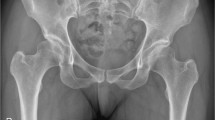Abstract
Purpose
The pararectus approach has been validated for managing acetabular fractures. We hypothesised it might be an alternative approach for performing periacetabular osteotomy (PAO).
Methods
Using four cadaver specimens, we randomly performed PAO through either the pararectus or a modified Smith-Petersen (SP) approach. We assessed technical feasibility and safety. Furthermore, we controlled fragment mobility using a surgical navigation system and compared mobility between approaches. The navigation system’s accuracy was tested by cross-examination with validated preoperative planning software.
Results
The pararectus approach is technically feasible, allowing for adequate exposure, safe osteotomies and excellent control of structures at risk. Fragment mobility is equal to that achieved through the SP approach. Validation of these measurements yielded a mean difference of less <1 mm without statistical significance.
Conclusion
Experimental data suggests the pararectus approach might be an alternative approach for performing PAO. Clinical validation is necessary to confirm these promising preliminary results.





Similar content being viewed by others
References
Ganz R, Klaue K, Vinh TS, Mast JW (1988) A new periacetabular osteotomy for the treatment of hip dysplasias. Technique and preliminary results. Clin Orthop Relat Res 232(232):26–36
Clohisy JC, Barrett SE, Gordon JE, Delgado ED, Schoenecker PL (2005) Periacetabular osteotomy for the treatment of severe acetabular dysplasia. J Bone Joint Surg Am 87(2):254–259
Hussell JG, Mast JW, Mayo KA, Howie DW, Ganz R (1999) A comparison of different surgical approaches for the periacetabular osteotomy. Clin Orthop Relat Res 363:64–72
Matta JM, Stover MD, Siebenrock K (1999) Periacetabular osteotomy through the Smith-Petersen approach. Clin Orthop Relat Res 363:21–32
Siebenrock KA, Scholl E, Lottenbach M, Ganz R (1999) Bernese periacetabular osteotomy. Clin Orthop Relat Res 363(363):9–20
Troelsen A, Elmengaard B, Soballe K (2008) Comparison of the minimally invasive and ilioinguinal approaches for periacetabular osteotomy: 263 single-surgeon procedures in well-defined study groups. Acta Orthop 79(6):777–784
Troelsen A, Elmengaard B, Soballe K (2008) A new minimally invasive transsartorial approach for periacetabular osteotomy. J Bone Joint Surg Am 90(3):493–498
Albers CE, Steppacher SD, Ganz R, Tannast M, Siebenrock KA (2013) Impingement Adversely Affects 10-year Survivorship After Periacetabular Osteotomy for DDH. Clin Orthop Relat Res
Clohisy JC, Schutz AL, John LS, Schoenecker PL, Wright RW (2009) Periacetabular osteotomy: a systematic literature review. Clin Orthop Relat Res 467(8):2041–2052
Hussell JG, Rodriguez JA, Ganz R (1999) Technical complications of the Bernese periacetabular osteotomy. Clin Orthop Relat Res 363(363):81–92
Davey JP, Santore RF (1999) Complications of periacetabular osteotomy. Clin Orthop Relat Res 363(363):33–37
Keel MJ, Ecker TM, Cullmann JL, Bergmann M, Bonel HM, Buchler L, Siebenrock KA, Bastian JD (2012) The pararectus approach for anterior intrapelvic management of acetabular fractures: an anatomical study and clinical evaluation. J Bone Joint Surg (Br) 94(3):405–411
Liu L, Ecker T, Schumann S, Siebenrock K, Nolte L, Zheng G (2014) Computer assisted planning and navigation of periacetabular osteotomy with range of motion optimization. Med Image Comput Comput Assist Interv 17(Pt 2):643–650
Puls M, Ecker TM, Steppacher SD, Tannast M, Siebenrock KA, Kowal JH (2011) Automated Detection of the Acetabular Rim Using Three-dimensional Models of the Pelvis. Comput Biol Med. article in press
Murray DW (1993) The definition and measurement of acetabular orientation. J Bone Joint Surg (Br) 75(2):228–232
Lavallee S (1996) Registration for computer-integrated surgery: methodology, state of the art. Comput Integr Surg 5(5):77–97
Keel MJ, Tomagra S, Bonel HM, Siebenrock KA, Bastian JD (2014) Clinical results of acetabular fracture management with the pararectus approach. Injury 45(12):1900–1907
Conflict of interest
The authors declare that they have no conflict of interest.
Research involving human participants and IRB approval
All studies were approved by the appropriate institutional and/or national research ethics committee and were performed in accordance with the ethical standards as laid down in the 1964 Declaration of Helsinki and its later amendments or comparable ethical standards.
Author information
Authors and Affiliations
Corresponding author
Rights and permissions
About this article
Cite this article
Liu, L., Zheng, G., Bastian, J.D. et al. Periacetabular osteotomy through the pararectus approach: technical feasibility and control of fragment mobility by a validated surgical navigation system in a cadaver experiment. International Orthopaedics (SICOT) 40, 1389–1396 (2016). https://doi.org/10.1007/s00264-015-2892-6
Received:
Accepted:
Published:
Issue Date:
DOI: https://doi.org/10.1007/s00264-015-2892-6




